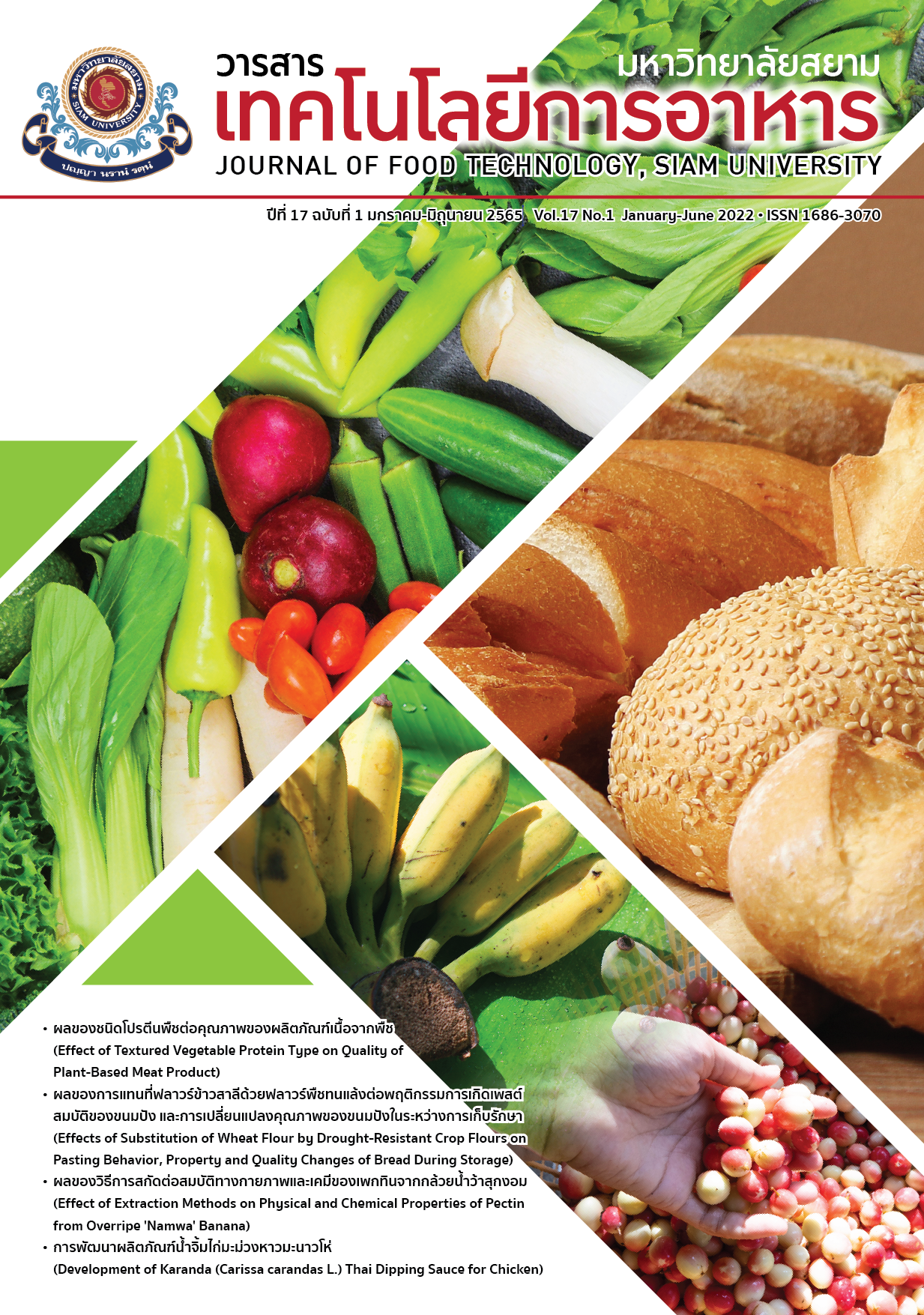Effects of Substitution of Wheat Flour by Drought-Resistant Crop Flours on Pasting Behavior, Property and Quality Changes of Bread During Storage
Main Article Content
Abstract
This study investigated pasting behavior of flour blends of wheat and drought-resistant crops (DRC), namely Job’s tears, millet, and chickpea, as well as to develop a bread product from such flour blends. Wheat flour was substituted with DRC flours at 3 different levels (10, 20 and 30% by weight). Regarding pasting behavior, DRC flour-substituting samples demonstrated reduced peak, trough, and breakdown viscosities as compared to the all-wheat control (p≤0.05). Adding Job’s tears or chickpea flour resulted in a decrease in pasting temperature as well as final and setback viscosities as compared to the control. Meanwhile, millet flour substitution did not affect such pasting properties. Upon substituting wheat flour in a bread recipe with DRC flour, the bread exhibited lower specific loaf volume than the control (p≤0.05). DRC flour substitution was shown to pose an effect on color of bread crust and crumb. Pertaining to textural properties, DRC flour addition caused an increase in hardness and chewiness of either freshly baked (Day 0) or stored bread samples. On the other hand, freshly baked DRC flour-containing breads exhibited lower springiness and cohesiveness than the control. However, upon storage, springiness and cohesiveness of the DRC flour-containing breads were similar to those of the control. Based on monitoring starch retrogradation, it was found that the breads with DRC flour had lower water-soluble starch content than the control for which the content became reducing with increasing substitution level.
Article Details

This work is licensed under a Creative Commons Attribution-NonCommercial-NoDerivatives 4.0 International License.
Copyrights of all articles in the Journal of Food Technology available in print or online are owned by Siam University and protected by law.
References
Dai, A. (2011). Drought under global warming: a review. WIREs Climate Change. 2(1): 45-65.
McGrath, M. (2012). Bananas could replace potatoes in warming world. BBC News. [Online] Available from http://www.bbc.co.uk/ news/science-environment-20126452. [Accessed September 3, 2021].
Alexandratos, N. (2006). World agriculture: towards 2030/2050, Interim report. Food and Agriculture Organization of the United Nations, Rome.
Tilman, D. and Clark, M. (2014). Global diets link environmental sustainability and human health. Nature. 515, 518-522.
Smith, P. and Gregory, P.J. (2013). Climate change and sustainable food production. Proceedings of the Nutrition Society. 72(1): 21-28.
Shahbandeh, M. (2021). Grain production worldwide 2020/21, by type. Statistica. [Online] Available from https://www. statista.com/statistics/263977/world-grain -production-by-type/. [Accessed October 23, 2021].
Tack, J., Barkley, A. and Nalley, L.L. (2015). Effect of warming temperatures on US wheat yields. Proceedings of the National Academy of Science of the United States of America. 112(22): 6931-6936.
CGIAR. (2015). Drought-tolerant crops for drylands. CGIAR. [Online] Available from http://www.cgiar.org/www-archive/www. cgiar.org/pdf/drought_tolerant_crops_for_drylands.pdf. [Accessed October 12, 2019].
Bao, J.S. (2008). Accurate measurement of pasting temperature by the rapid visco-analyser: A case study using rice flour. Rice Science. 15(1): 69-72.
Khunta, F. (2009). Effects of hydroxypropylmethyl cellulose and carboxymethyl cellulose on staling and keeping quality of wheat bread. Master’s thesis, Chulalongkorn University, Bangkok (in Thai).
AOAC. (2005). Official methods of analysis (18th ed.). Association of Official Analytical Chemists. Washington, D.C.
Bárcenas, M.E. and Rosell, C.M. (2006). Different approaches for improving the quality and extending the shelf life of the partially baked bread: Low temperatures and HPMC addition. Journal of Food Engineering. 72(1): 92-99.
Shaikh, I.M., Ghodke, S.K. and Ananthanarayan, L. (2007). Staling of chapatti (Indian unleavened flat bread). Food Chemistry. 101(1): 113-119.
Blazek, J. and Copeland, L. (2008). Pasting and swelling properties of wheat flour and starch in relation to amylose content. Carbohydrate Polymers. 71(3): 380-387.
Gómez, M., Oliete, B., Rosell, C.M., Pando, V. and Fernández-Fernández, E. (2008). Studies on cake quality made of wheat–chickpea flour blends. LWT. 41(9): 1701-1709.
Ragaee, S. and Abdel-Aal, E.M. (2006). Pasting properties of starch and protein in selected cereals and quality of their food products. Food Chemistry. 95(1): 9-18.
Ahmed, J. and Thomas, L. (2007). Pasting properties of starch: Effect of particle size, hydrocolloids and high pressure. In J. Ahmed (ed.), Glass transition and phase transitions in food and biological materials (pp. 427-451). John Wiley & Sons, West Sussex.
Lazaridou, A., Duta, D., Papageorgiou, M., Belc, N. and Biliaderis, C.G. (2007). Effects of hydrocolloids on dough rheology and bread quality parameters in gluten-free formulations. Journal of Food Engineering. 79(3): 1033-1047.
Wikipedia. (2020). Chickpea bread. [Online] Available from https://en.wikipedia.org/ wiki/Chickpea_bread. [Accessed December 24, 2021].
Rattanapanone, N. (2014). Food chemistry. Odeon Store, Bangkok (in Thai).
USDA. (2021). Food Data Central. USDA. [Online] Available from https://fdc.nal. usda.gov/. [Accessed January 18, 2021].
Li, W., Gao, J., Wu, G., Zheng, J., Ouyang, S., Luo, Q. and Zhang, G. (2016). Physicochemical and structural properties of A- and B-starch isolated from normal and waxy wheat: Effects of lipids removal. Food Hydrocolloids. 60: 364-373. doi:10.1016/ J.FOODHYD.2016.04.011
Naivikul, O. and Pornkitprasan, T. (1987). Comparison of chemical and physical properties of Job's tears flour and starch. Kasetsart Journal, Natural Science. 21(4): 371-377. (in Thai).
Mahajan, P., Bera, M.B., Panesar, P.S. and Chauhan, A. (2021). Millet starch: a review. International Journal of Biological Macromolecules. 180(3): 61-79.


